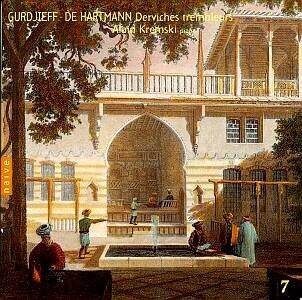 Composer: Georges Gurdjieff
Composer: Georges Gurdjieff
Works: Piano Music, Volume 7 “Derviches Trembleurs”, Volume 9 “Les Cercles”
Performers: Alain Kremski (piano)
Recording: Recorded at Opus Systeme (Vanves, France) September 1998
Label: Auvidis Naive
The collaboration between Georges Gurdjieff, a philosopher and mystic, and Thomas de Hartmann, a trained musician, resulted in a unique body of piano music that reflects Gurdjieff’s synthesis of Eastern and Western musical traditions. These recordings present a selection of pieces that emanate from Gurdjieff’s travels and spiritual teachings, transcribed and arranged by de Hartmann. The music encapsulates a rich historical tapestry that spans the early 20th century, characterized by a quest for authenticity and a return to foundational truths. These qualities are evident in both volumes, which reveal an intriguing interplay between the esoteric and the accessible.
Alain Kremski’s performance navigates the delicate terrain between Gurdjieff’s original thematic sketches and de Hartmann’s interpretative arrangements. Kremski demonstrates a deft understanding of the music’s underlying emotional currents, employing a nuanced touch that varies from the meditative to the exuberant. His interpretation of pieces such as “Dervish Dance” captures the hypnotic quality inherent in the work, emphasizing rhythmic repetition and subtle dynamic shifts that evoke a trance-like state. Kremski’s ability to highlight these characteristics is particularly compelling in tracks like “Adam and Eve,” where a delicate balance of fragility and vigor is maintained, showcasing the dual nature of Gurdjieff’s musical vision.
From a technical standpoint, Kremski’s execution is commendable. His command of the instrument allows for the exploration of the wide range of timbres that these works demand. The recording quality, engineered with sensitivity, allows the resonant qualities of the Steinway piano to shine through, with a clarity that enhances the intimacy of the performance. The piano is positioned prominently in the mix, offering a vibrant sound that captures the intricate details of Kremski’s playing, from the crisp articulation of melodic lines to the lush harmonies that underpin the compositions. The engineering also facilitates a spatial awareness, immersing the listener in the sonic landscape crafted by Kremski.
In terms of interpretation, Kremski’s choices are informed by an understanding of Gurdjieff’s philosophical underpinnings, yet he avoids being overly didactic. Instead, he invites the listener into a contemplative experience that transcends the mere act of performance. This is particularly evident in pieces like “Kurd Shepherd Melody,” where Kremski’s pacing allows for spaces of silence that accentuate the music’s meditative qualities. His ability to invoke a sense of place and atmosphere stands in contrast to other recordings, which may tend toward a more straightforward or technically rigid approach. Kremski’s interpretative freedom adds a layer of depth to the performances that resonate long after the last note has faded.
The absence of substantial program notes regarding the individual pieces is a missed opportunity, particularly when considering the wealth of philosophical context surrounding Gurdjieff’s music. While the liner notes provide some background, they often delve into Gurdjieff’s esoteric teachings rather than illuminating the music itself. This lack of detail may leave listeners unfamiliar with the historical and cultural significance of the works somewhat adrift. Nonetheless, Kremski’s evocative performance serves as a bridge, allowing the music to speak for itself, even if the listener is not privy to all its intricacies.
The offerings found in these two volumes are a rewarding exploration of a lesser-known musical canon. Kremski’s artistry, coupled with the thoughtful recording quality, creates an engaging listening experience that both honors and revitalizes Gurdjieff’s vision. For those with an appreciation for the intersection of philosophy and art, these recordings provide a compelling invitation to explore the depths of musical expression that Gurdjieff and de Hartmann have to offer. The recordings serve not merely as a collection of piano music but as an entry point into a profound dialogue between the listener and the mystical narrative that underpins these evocative pieces.



